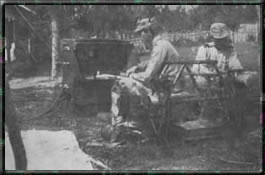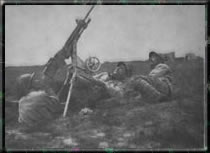Rebirth of the army : January to May 1917
Organization
At the start of 1917, the Romanian army was down to 300.000 men. Therefore, the 1917 and 1918 generations were called up and some of the auxiliary personnel was used to rebuild the fighting units, until the regular army was 460.000 men strong. But these men had to be equipped with modern weapons if they were to stand any chance of victory in the coming battles. Throughout the winter, the army's arsenal and several factories, improvised with whatever machineries that had been hastily evacuated in 1916 into Moldavia or imported, worked day and night to manufacture the badly needed weapons and ammunitions. Still, the army couldn't have been properly equipped if the long-awaited shipments of armament had not finally arrived. From February to April 1917, large amounts of modern weapons arrived at last from France : 150.000 rifles, 1957 medium machine guns, 2736 light machine guns, 1.300.000 grenades, 184 light artillery pieces ( 75 mm guns ), almost 300 heavy artillery pieces ( 105 mm and 120 mm long-range guns, 150 mm and 152.4 mm Schneider-Creusot heavy howitzers and even some 210 mm "super-heavy" guns ), 130 trench mortars ( 58 mm ). The fledgling Romanian air force received some 100 fighters, reconnaissance planes and light bombers. The infantry received new helmets, gas masks for every frontline soldier and large amounts of communication equipment, including telephones and wireless telegraphy devices. Some armored cars were also delivered, whilst the workshops improvised a few more using existing automobiles. All the "armor" was given to the cavalry units, which were also rebuilding. Even a batch of 50 Renault FT17 light tanks had been ordered but these didn't arrive until after the war. The French had actually dispatched even larger amounts of weapons and equipment, but some 40% of them mysteriously "disappeared" somewhere in Russia during transit. In spite of all the Romanian protests, the missing shipments were never recovered, thus forcing the Romanian government to pay for something it hadn't received.

The Romanian troops spent the spring of 1917
training with the new equipment and improving the battle tactics. A French
military mission, led by general Berthelot arrived in late 1916, bringing in
numerous and experienced French advisors. These men passed their knowledge of
trench warfare and modern tactics to the Romanian officers and soldiers. There
were occasional frictions because of the "big brother" attitude of some
Frenchmen. But, overall the reports were excellent, as the Romanians had
realized that the realities of modern warfare demanded new skills and worked
feverishly to adapt their tactics to the modern battlefield.
